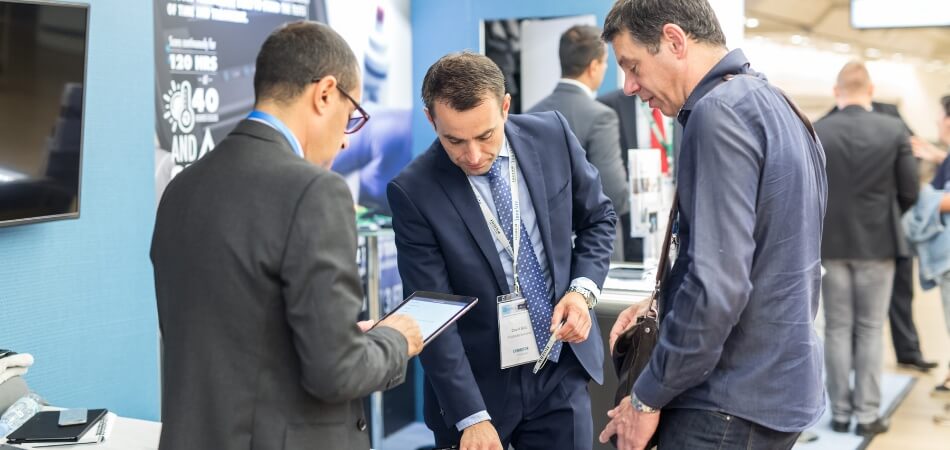Trade shows are a bustling, vibrant world, and one of the most important components is the vendor stall. These compact yet efficiently designed spaces are the heart of any trade show, serving as miniature showcases for brands to display their products. A common question among newcomers and seasoned exhibitors alike is, “What is the size of a vendor stall?”
Typically, these stalls are modest in size, measuring around 10 feet by 10 feet. This standard dimension provides enough room for brands to creatively display their offerings while ensuring a streamlined visitor traffic flow.
Interested in learning more about how to make the most of these dimensions? Stay with us as we delve deeper into the world of vendor stalls, offering tips and insights on how to maximize your presence within this standard space.
What’s the Purpose of the Vendor Stall at Trade Shows?
Vendor stalls at trade shows serve as vital platforms for brands to showcase their products and services. They create an interactive space where businesses can engage directly with potential customers and industry peers.
These stalls are not just about sales but also about building relationships and brand awareness. In the bustling environment of a trade show, a vendor stall acts as a brand’s stage. It’s where companies demonstrate their latest offerings and innovations, attracting attention from attendees.
More than just a display area, these stalls are networking hubs, facilitating valuable connections with other professionals and consumers. Businesses gain insights, feedback, and opportunities crucial for growth and development through these interactions. Vendor stalls, therefore, play a multifaceted role in the dynamic ecosystem of trade shows.
What is the Size of a Vendor Stall?
The typical size of a vendor stall at trade shows is about 10 feet by 10 feet, a standard that balances space efficiency with functionality. This dimension allows for an optimal display of products while ensuring enough room for visitor engagement and interaction. The size is crucial for creating an inviting and accessible environment for both exhibitors and attendees.

Trade Show Venue
The size of the venue plays a significant role in determining stall sizes. Larger venues can accommodate bigger stalls, offering more space for elaborate displays. In contrast, smaller venues often necessitate compact stalls to maximize the number of exhibitors. This balancing act ensures efficient use of space while catering to diverse exhibitor needs.
Venue constraints also influence stall layout and design. Organizers must consider factors like aisle spacing, emergency exits, and visitor flow when allocating stall sizes. Consequently, the venue’s architecture and floor plan directly impact how vendor stalls are sized and arranged.
Exhibitor Requirements
Exhibitors’ specific needs significantly influence the size of a vendor stall. Brands with extensive product ranges or elaborate display requirements might opt for larger spaces. This allows for a more comprehensive showcase, enhancing visitor experience and product interaction.
On the other hand, startups or businesses with limited product lines may prefer smaller stalls. These compact spaces can be more cost-effective and easier to manage, particularly for first-time exhibitors. Tailoring stall size to exhibitor requirements ensures a practical and effective trade show presence for businesses of all scales.
The size of a vendor stall is a critical aspect that shapes the trade show experience. It is influenced by the venue’s capacity and the specific needs of exhibitors. Understanding these factors helps optimize the use of space, ensuring that each stall is a microcosm of innovation and engagement within the bustling trade show environment.
Different Types & Sizes of Vendor Stall
Vendor stalls, pivotal in shaping the dynamic landscape of trade shows, come in various types and sizes. Each type caters to different exhibitor needs, from showcasing expansive product lines to highlighting select items. Understanding these variations is key to selecting the right stall for your brand’s unique requirements.

Standard Booth
Standard booths, typically measuring 10 feet by 10 feet, are the most common type found in trade shows. They offer sufficient space for basic displays and are ideal for small to medium-sized businesses. These booths are cost-effective and provide a straightforward setup for exhibitors focusing on efficiency.
Island Booth
Island booths are larger, often spanning 20 feet by 20 feet or more, and are accessible from all sides. This type of stall is designed for major exhibitors with extensive product ranges. It allows for a more immersive experience and is perfect for interactive displays or demonstrations.
Inline Booth
Inline booths, usually 10 feet by 10 feet, are arranged in line with neighboring stalls. They are ideal for creating a unified look in a row and work well for vendors with focused displays. This type offers a compact and efficient space for exhibitors with limited products.
Peninsula Booth
Peninsula booths, often 20 feet by 20 feet, are open on three sides and attached to a neighboring stall on one side. These are suitable for exhibitors seeking high visibility and space for elaborate setups. They offer a blend of openness and substantial display area.
The diversity in vendor stall types and sizes reflects the varied needs of exhibitors at trade shows. From the compact efficiency of standard booths to the expansive allure of island booths, there’s a space for every exhibitor’s vision. Choosing the right type and size is essential for showcasing your brand effectively and creating a memorable presence at the event.
How to Determine the Right Size for Your Vendor Stall?
Choosing the right size for your vendor stall is a strategic decision that can significantly impact your trade show success. It involves understanding your brand’s needs, the nature of your products, and the anticipated visitor interaction. The aim is to balance space, cost, and effective display.
Assessing Product Display Requirements
Begin by evaluating the space your products need for an effective display. Consider the dimensions and quantity of your products and if they require interactive or static displays. Larger, interactive products might necessitate more space, while smaller items can fit into compact stalls.
Factor in storage needs for additional stock and display materials. Having adequate space for these elements is crucial to avoid clutter. A well-organized stall enhances product visibility and accessibility, creating a positive visitor experience.
Anticipating Customer Flow
Estimate the number of visitors you expect at your stall. High-traffic stalls require more space to accommodate visitors comfortably without overcrowding. Consider the nature of interaction – will your stall host demonstrations or one-on-one interactions?
Design your stall layout to facilitate smooth visitor flow. Ensure enough room for people to move around and engage with your products. A cramped space can deter visitors, while too much space might make the stall appear empty.
Budget Considerations
Your budget is a key factor in determining stall size. Larger stalls often have higher rental costs, so balance space needs with financial constraints. Consider the return on investment – a larger stall might drive more engagement, but is it cost-effective?
Also, factor in additional costs like design, setup, and staffing for larger stalls. It’s essential to align the stall size with your overall event budget to ensure a sustainable and profitable presence.
Determining the right size for your vendor stall is a nuanced process that requires careful consideration of your display needs, anticipated customer interaction, and budget. By aligning these aspects with your overall trade show strategy, you can select a stall size that optimizes your brand’s presence and enhances the visitor experience, ensuring a successful and impactful event.
Tips to Help You Utilize the Every Inch of a Vendor Stall
Maximizing every inch of your vendor stall is crucial for creating an impactful and memorable trade show presence. Efficient use of space enhances the aesthetic appeal of your stall and improves visitor experience. Here are some practical tips to help you utilize your stall space effectively.

- Strategic Layout Design: Plan your stall layout meticulously, ensuring clear pathways for visitors. This promotes easy navigation and allows for a comfortable browsing experience.
- Vertical Display Solutions: Utilize vertical space with shelves or hanging displays. This approach increases product visibility without crowding the stall floor.
- Multifunctional Furniture: Opt for furniture that serves dual purposes, like storage-cum-display units. This helps in reducing clutter while maximizing functional space.
- Compact and Foldable Fixtures: Use foldable or compact fixtures that can be easily rearranged. This flexibility allows for adjustments based on visitor flow and interaction.
- Bright and Effective Lighting: Implement bright, targeted lighting to highlight products and create an inviting atmosphere. Good lighting can make your stall appear larger and more welcoming.
- Digital Displays: Incorporate digital displays for product information or demonstrations. This reduces the need for physical space while engaging visitors effectively.
- Minimalistic Design Approach: Adopt a minimalistic design to avoid overcrowding the stall. Focus on key products or messages for a clean, organized appearance.
- Interactive Elements: Include interactive elements like touchscreens or QR codes for information. These take up little space while enhancing visitor engagement.
Effectively utilizing every inch of your vendor stall is about smart planning, creative solutions, and a focus on the visitor experience. By implementing these tips, you can create a stall that stands out and efficiently showcases your products and brand, making every square foot count in your trade show journey.
Bottom Lines
Trade shows are a vibrant world where understanding what is the size of a vendor stall is just the beginning. The journey towards a successful exhibition involves meticulous planning and strategic use of space. Whether it’s a standard 10×10 booth or a larger island stall, each type offers unique opportunities for showcasing your brand.
Key to this is a deep understanding of your products, audience interaction, and budget constraints, which guide the choice of the right stall size. Utilizing every inch effectively, from adopting a strategic layout to incorporating digital displays, transforms your stall into an engaging and memorable space.
This comprehensive approach, which balances aesthetic appeal with functional design, enhances visitor experience and maximizes your trade show presence, making every square foot count. Remember, the success of your vendor stall lies not just in its size but in how creatively and efficiently you use the space.


